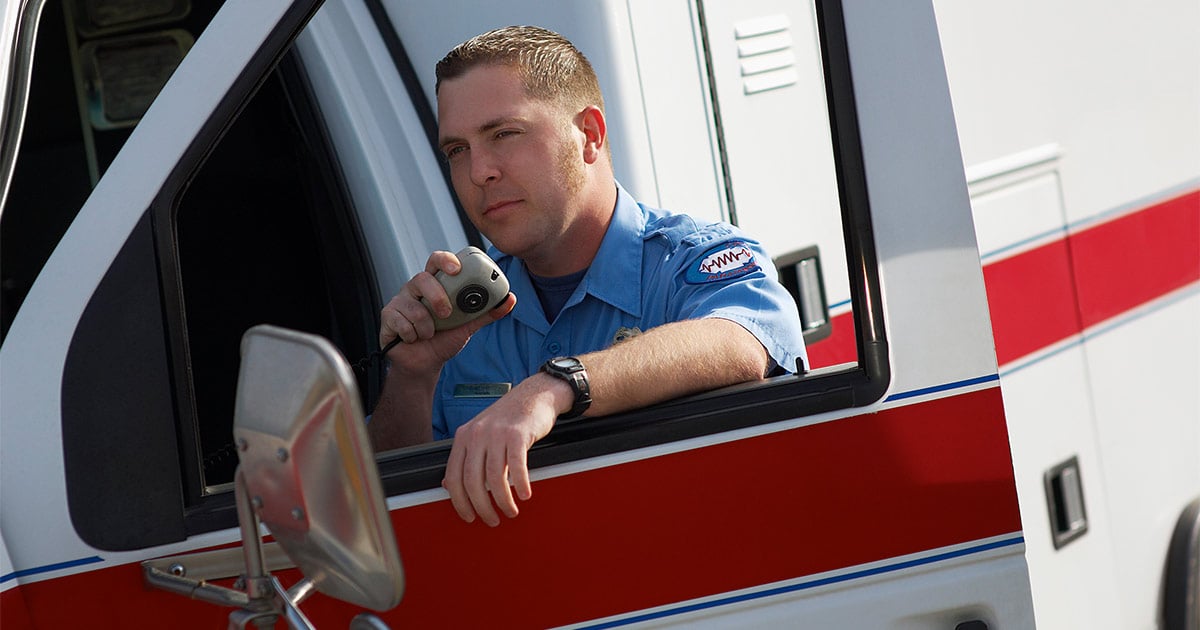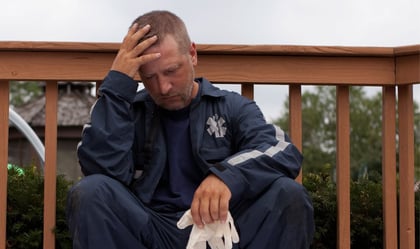Pulsara Around the World - 2025 Recap and January 2026
December Recap After an incredibly busy events year with 102 conferences, trade shows, and sponsorships, December was on the slower side for us, with...
6 min read
 Team Pulsara
:
Mar 01, 2021
Team Pulsara
:
Mar 01, 2021

For a long time, traumatic stress and Post-Traumatic Stress Disorder have been conditions associated with those that have experienced combat or been in the military. Recently, there has been mounting evidence that first responders are also experiencing these conditions at alarming rates, and that we need to make our own mental health a priority.
For a long time mental health, self-care, and peer-care have been taboo subjects among first responders. Thankfully, that is beginning to change, and discussion of these topics has been encouraged. Knowing more about first responder mental health can help you participate in the conversation, help yourself, and help your peers.
 Stress is a normal reaction to the physical and mental demands you face in your daily life. When you are under stress, your brain reacts by providing a quick burst of hormones, endorphins, and neurotransmitters all designed to help your body function more efficiently. There are two main types of stress: Traumatic stress and chronic stress.
Stress is a normal reaction to the physical and mental demands you face in your daily life. When you are under stress, your brain reacts by providing a quick burst of hormones, endorphins, and neurotransmitters all designed to help your body function more efficiently. There are two main types of stress: Traumatic stress and chronic stress.
Traumatic stress is usually triggered by an event—or series of events—that overwhelm your ability to cope. [1, 2, 3] For first responders, this can include some of the situations you might encounter while on the job.
When your body endures chronic stress, the chemicals that help you cope continue to float around in your body. Though helpful in the short term, their continued presence can negatively impact your blood pressure, sleep, and immune system.
Both types of stress assist you in getting through an immediate situation, but can also become harmful when prolonged or occurs after a traumatic event. Chronic stress has been linked to increased rates of anxiety and depression, as well as a number of physical ailments. Traumatic stress can result in the development of an Acute Stress Reaction or Post-Traumatic Stress Disorder (PTSD). [1, 2, 3]
Part of addressing a problem is knowing the scope. According to a literature review published by JEMS in July 2020, several studies done worldwide suggest that around 40% of first responders are either at a high risk for or have screened positive for PTSD. This is an increase from older studies, which estimated that the rate of Post-Traumatic Stress Disorder in first responders to be around 15-25%. [4, 5, 6]
First responder suicides are not tracked by the government like line of duty deaths are, leaving the task up to independent groups. The Firefighter Behavioral Health Alliance is the primary group tracking fire and EMS suicides in the US, with The Code Green Campaign assisting in gathering data. The FFBA estimates that they may only be catching about 30% of first responder suicides. This means that we may be losing one fire/EMS responder a day to suicide...and more if law enforcement is included. [7]
Post-Traumatic Stress Disorder is a psychological disorder that can develop in some people after being exposed to either a single or multiple traumatic events. In simple terms, when someone has PTSD, their “fight-or-flight” response gets stuck on, or turns on excessively. PTSD symptoms fall into four categories: arousal, avoidance, cognition, and re-experiencing. A person must experience a certain number of symptoms from each category for PTSD to be diagnosed. [2]
You can read the National Institute of Mental Health’s explanation of the individual symptoms here.
 Resilience is an individual’s ability to deal with stress and recover from traumatic events. In other words, how well you are able to “bounce-back” from these experiences. There are many things that factor into how resilient a person is, including their upbringing, family life, social life, and past trauma. The good thing about resilience is that it can be developed and increased, often on your own. The American Psychological Association’s Road to Resilience guide is a helpful resource to learn about resilience factors. [8]
Resilience is an individual’s ability to deal with stress and recover from traumatic events. In other words, how well you are able to “bounce-back” from these experiences. There are many things that factor into how resilient a person is, including their upbringing, family life, social life, and past trauma. The good thing about resilience is that it can be developed and increased, often on your own. The American Psychological Association’s Road to Resilience guide is a helpful resource to learn about resilience factors. [8]
It is important to know what to look for when you are worried about someone. There are a number of different warning signs, including changes in behavior, changes in mood, and statements that someone might make. Extrinsic factors, like job loss or divorce, can also increase the risk of someone having a crisis or attempting suicide.
Check out the SAMHSA site for Warning Signs and Risk Factors for Emotional Distress and the American Foundation for Suicide Prevention’s site on Risk Factors and Warning Signs for detailed information on what to look out for. [9]
If you’re worried about someone, talk to them! You may be the only person who sees something, and saying something may save a life. It is normal to be anxious when having a conversation with someone about their mental health, and having a plan can make it easier to talk to them. There are 3 key steps to talking to someone about their mental health:
Be sure to use active listening; it's vital to let the person know you are listening to what they are saying. Don’t be afraid to ask direct questions such as “are you thinking about suicide?” or “do you have a plan to kill yourself?” You will not put the idea of suicide in their head.

Though we often offer advice with the best of intentions, some common approaches won't have quite the effect we hope they will. If someone confides in you that they are struggling with a mental health problem, you should avoid:
These approaches may be well-meaning, but they will not be helpful. Listening is often much more helpful than having the "right" thing to say.
Keep information on hand for different mental health resources, such as your agency’s EAP, a local crisis line, or national hotline. SafeCallNow operates a 24/7 crisis hotline staffed by first responders which can be reached at 206-459-3020. The Code Green Campaign also maintains a database of first responder-friendly mental health resources on their website.
Unfortunately, there tends to be a culture of silence among first responders when it comes to mental health. We are the ones people call when they need help, and we can be hesitant to admit that sometimes, we need help too. Changing the culture and reducing the stigma can go a long way towards improving the situation.
 You can help by avoiding making jokes about mental health or statements that might be seen as mocking mental health patients. When you see or hear people contributing to the stigma, speak up and say something so they understand that what they are saying and doing may be harmful to their fellow first responders.
You can help by avoiding making jokes about mental health or statements that might be seen as mocking mental health patients. When you see or hear people contributing to the stigma, speak up and say something so they understand that what they are saying and doing may be harmful to their fellow first responders.
For those in positions of influence and leadership, it's important to approach your people with a great deal of empathy and an emphasis on the importance of seeking help. Modeling a willingness to seek therapy can go a long way toward establishing a positive attitude toward mental health within your organization.
For more information on promoting mental and physical health among first responders, check out the Lexipol webinar The Ready Responder: How Physical and Mental Wellbeing Affects Performance.
You don’t have to learn everything about first responder mental health in order to help the cause! There are many groups working to improve awareness and education. Familiarize yourself with some of these organizations so that you can refer people to them if they want to learn more.
Organizations include:
In Canada:
1. What Is Traumatic Stress?. International Society for Traumatic Stress Studies, n.d. Web. 24July 2016.
2. Post-Traumatic Stress Disorder. National Institute of Mental Health, n.d. Web. 22 July 2016.
3. Fact Sheet On Stress. National Institute of Mental Health, n.d. Web. 22 July 2016.
4. Bennett, P. "Levels of Mental Health Problems among UK Emergency Ambulance Workers." Emergency Medicine Journal 21.2 (2004): 235-36. Web.
5. Lima, Eduardo De Paula, and Ada Ávila Assunção. "Prevalência E Fatores Associados Ao Transtorno De Estresse Pós-Traumático (TEPT) Em Profissionais De Emergência: Uma Revisão Sistemática Da Literatura." Rev. Bras. Epidemiol. Revista Brasileira De Epidemiologia 14.2 (2011): 217-30. Web.
6. Almeida, Maiara Luvizon Biancon De. "Prevalence Of Posttraumatic Stress Disorder In Rescue Workers: A Systematic Review." Psic., Saúde & Doenças Psicologia, Saúde & Doenças 13.2 (2012): 220-37. Web.
7. Firefighter Behavioral Health Alliance
8. The Road to Resilience. American Psychological Assocation, n.d. Web 24 July 2016.
9. Warning Signs and Risk Factors for Emotional Distress. Substance Abuse and Mental Health Services Administration, n.d. Web. 22 December 2020.
EDITOR'S NOTE: This article was originally published on EMS1 in April 2017, written by special guest blogger Ann Marie Farina—member of the EMS1 Editorial Advisory Board—as content sponsored by Pulsara through EMS1 BrandFocus. It has been revised, updated, and expanded for current accuracy and comprehensiveness.
Want more practical ideas for finding time to take care of yourself? Check out Take Care of Your Star Player: Health and Wellness in EMS.

December Recap After an incredibly busy events year with 102 conferences, trade shows, and sponsorships, December was on the slower side for us, with...

Editor's Note: In July 2025, EMS1 and Fitch & Associates released their annual EMS trend survey, What Paramedics Want, proudly sponsored by Pulsara....
![[PRESS RELEASE] Published Research Finds Up to 31% Faster STEMI Treatment Times in Rural Hospital Setting with Pulsara](https://www.pulsara.com/hubfs/_1_website-page-blog-assets/pulsara-hosp-teams-assign-cardio-stemi-rn-1200x701.jpg)
Published research shows how using Pulsara, alongside standardized field activation and a focus on stakeholder relationships, improves STEMI care and...